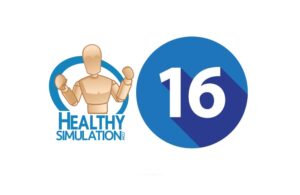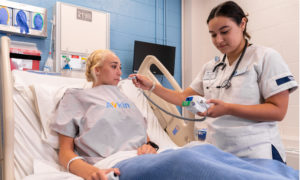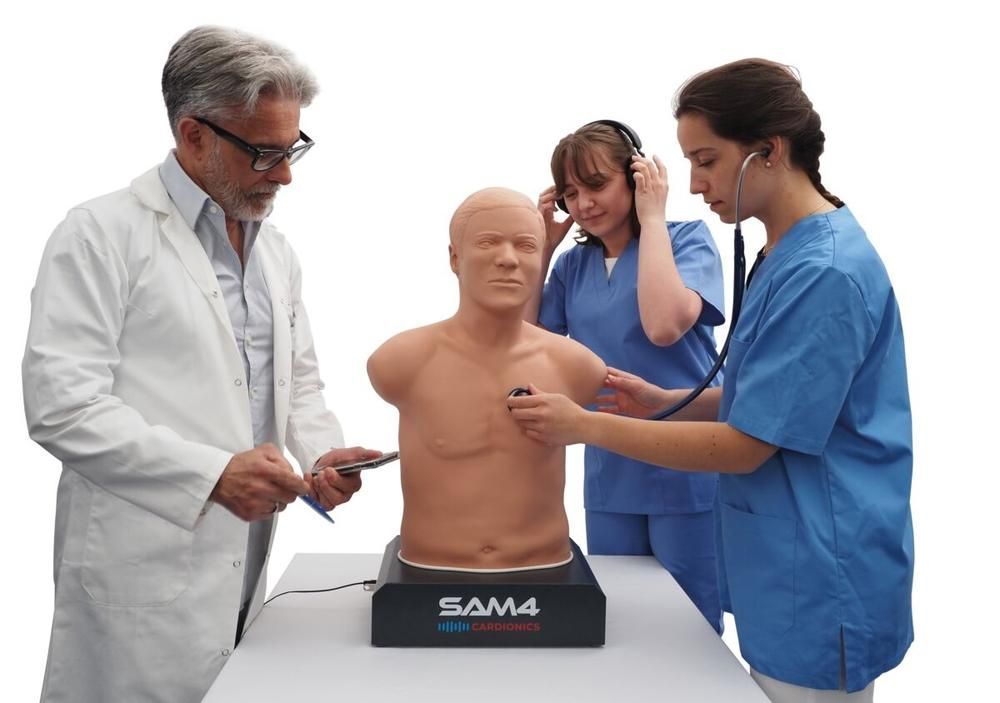Auscultation Simulator
An auscultation simulator is a healthcare simulation training device that allows learners to auscultate a variety of normal and abnormal body sounds with a simulated stethoscope. A heart and lung sounds simulator is helpful for healthcare professional students and junior staff members to refine the new skill of auscultation. Inexperienced healthcare professionals desire experience to listen to a variety of heart, lung and bowel sounds prior to assessments of patients in clinical care and so training through auscultation simulation should always be considered by clinical faculty.
The differentiation and diagnosis of such a wide variety of sounds heard on auscultation can cause overwhelm to more junior healthcare clinical staff until mastery is achieved. The ability to differentiate normal in comparison to abnormal auscultation sounds on an auscultation simulator can assist greatly with confidence and knowledge bases for healthcare professionals. An auscultation simulator is useful to universities and educational institutions which train healthcare professionals that require patient auscultation as a skill set. An auscultation simulator can be useful for any organization that will train junior staff members to gain experience in the skillset of auscultation.
When in the market to purchase an auscultation simulator consideration by the purchaser should be made as to what auscultation sounds should be prioritized as a manikin feature. A number of lung sound auscultation trainers have a large library of available auscultation sounds and features available. An awareness of the priorities of these sounds should be at the forefront of mind for the purchaser. Consideration should be given to versatility for potential use across multiple areas to capture a larger number of learners.
Sponsored Content:
Avkin Provides Wearable Simulators for Auscultation Training
Avkin has a wearable auscultation simulator called Avtone. Avtone is able to be worn by simulated patients and has heart and lung sounds which are operated by facilitators in an app feature. Learners are able to auscultate heart and lung sounds from this lung sound simulator as normal with a stethoscope. The Avtone has three skin tones available for purchase which means that a more diverse population of simulated patients can wear a simulator that matches close to their skin tone.
View the HealthySimulation.com LEARN CE/CME Platform Webinar Is Clinical Simulation Moving Into a Post Plastic Era with Wearable Simulators? to learn more!
Nasco Healthcare’s Manikin Covers Heart and Lung Sounds
Sponsored Content:
The life/form Keri auscultation manikin by Nasco has auscultation sites for both heart and lung sounds. The heart auscultation sites have six locations and have twelve heart condition auscultation sounds. Heart conditions covered in the Keri auscultation manikin include:
- Aortic regurgitation
- Atrial septal defect
- Holosystolic and midsystolic
- Mitral stenosis, normal
- PDA
- Pulmonary stenosis
- S3 Gallop and S4 Gallop
- Systolic click
- VSD
The lung sites for auscultation include five anterior, six upper posterior, four lower posterior, and two midaxillary locations which covers in total twelve lung conditions. Lung conditions which can be auscultated on the Keri auscultation manikin include:
- Bronchial
- Cavernous
- Coarse and fine crackle
- Friction rub
- Mono wheeze
- Normal
- Pectoriloquy
- Pulmonary edema
- Rhonchi
- Stridor, and wheeze.
In addition to the twenty four heart and lung sounds that can be auscultated on the Keri auscultation manikin, there is the ability to simulate over thirty-five nursing and medical procedures which makes this manikin incredibly versatile for multiple uses.
Cardionics Has a Long History of Simulated Stethoscope Simulators
SAM Basic – Affordable Adult Auscultation Manikin: The SAM Basic auscultation training manikin has been developed to teach and train to assess heart, lung, bowel and bruit conditions. In combination with SimScope, an electronic simulation-training stethoscope, students can train in the recognition of auscultation sounds associated with various disorders.
The SAM basic library consists of:
- 18 heart
- 20 lung,
- 6 bowel sounds
- 1 bruit sound and also Covid-19 auscultation lung sound.
The sounds can be altered with the SimScope’s own Wi-Fi. Up to 5 SimScopes can be connected and operated from the controller tablet if purchased. The SAM basic is also available in two skin versions, light and dark.
SAM4 Auscultation Manikin
The SAM4 manikin has the new SAM4 app, which is compatible with both iOS and Android to manage the manikin. LED Lights are at all auscultation points that are positioned at each auscultation point. These built-in lights show the correct positions for sound examination, so learners can easily identify and focus on the appropriate areas for auscultation.
The auscultation library consists of:
- 37 heart sounds
- 11 heart-lung combinations
- 26 lung sounds
- 9 bowel sounds
- 6 bruit sounds
The ultimate version of SAM4 contains 25 Real Sounds, 12 echocardiogram videos, and 3 Dynamic Sounds. ECG waveforms are also included for all heart sounds. Auscultation can occur with any clinical stethoscope used by the learner. There is a palpable carotid pulse and the manikin is controlled with a smartphone or tablet via App available for iOS and Android devices. There is also an availability of 7 languages: English, French, German, Polish, Portuguese, Russian, and Spanish.
Auscultation simulators are essential simulation products that allow learners to practice the art of auscultation to learn how to identify a variety of normal and abnormal body sounds with a stethoscope. The healthcare simulator capabilities continue to grow, so each organization needs to remain aware of the equipment and learning opportunities to help their learners achieve the outcomes and objectives. HealthySimulation.com is a great resource to gather clinical simulation information for the latest updates.
Gaumard Manufactures High Fidelity Simulators with Lung Auscultation
Gaumard has an adult heart and lung auscultation simulator HAL. The HAL manikin is designed to assist to teach site-specific heart and lung auscultation skills. Learners press the bell of the stethoscope provided with the HAL manikin against the skin of the manikin and listen. The learners are able to use both realistic and palpable anatomic landmarks on the manikin in order to locate the sites where a certain sound should be heard. If the stethoscope is correctly placed on the manikin, the learner will hear an appropriate sound through the stethoscope and/or external speakers. The external speakers mean that all learners in the classroom can hear the sounds that are also auscultated, increasing the reach of learning. The HAL manikin also has the ability to have open or closed eyes and pupillary reflexes that can also be altered for learners. The HAL manikin is on a stand and is an assessment manikin. The HAL manikin combines both adult and some pediatric specific auscultation sounds for heart and lung assessments which makes this manikin versatile for a number of learners and educational environments.
Sounds that are able to be auscultated on the HAL manikin include:
- Venous Hum
- Aortic stenosis
- Split S2
- Pulmonary stenosis
- Systolic fixed S2
- 1 year old and 6 year old heart
- Stills Murmur
- Mitral valve regurgitation
- Split S1
- Normal infant and child
- Stridor
- Wheeze
- Ronchi
Stethoscope Simulator Latest News

16 Must-Know Healthcare Simulation Key Terms

Avkin’s Vital Signs Package Helps Clinical Simulations Maintain Realism
Sponsored Content:














